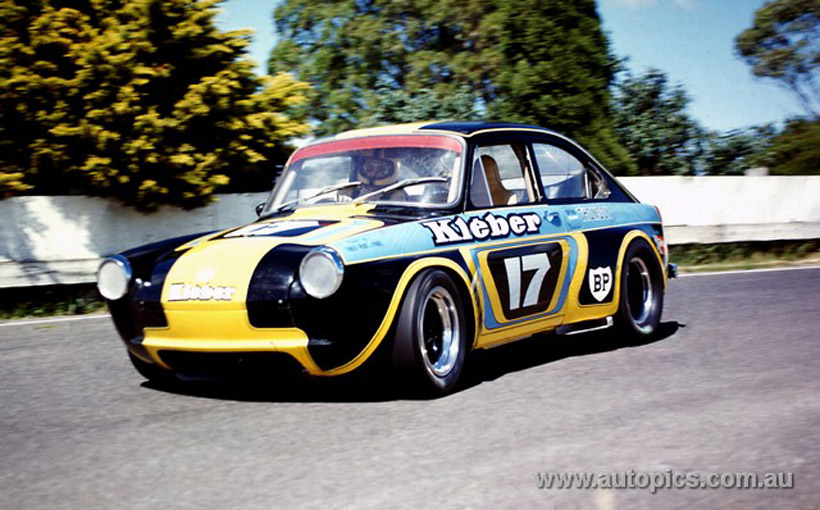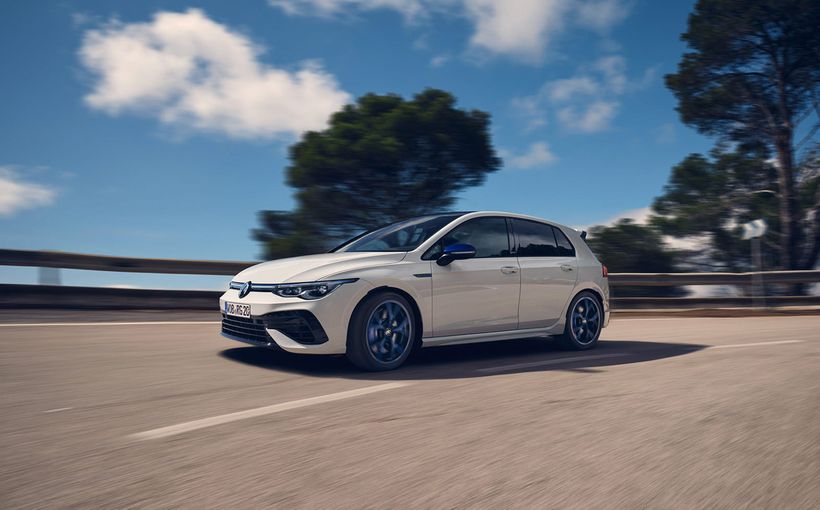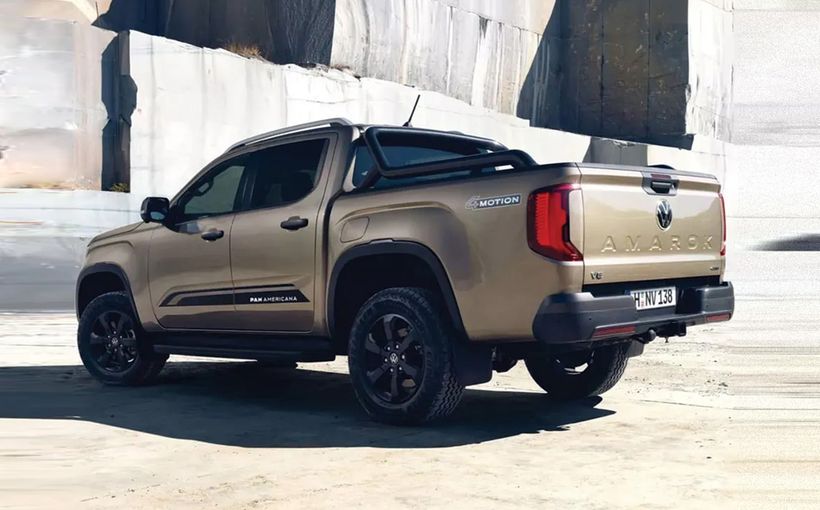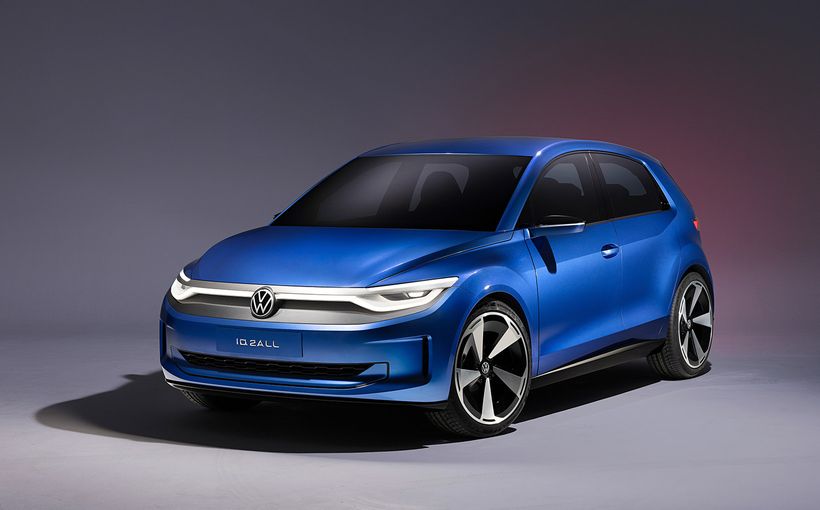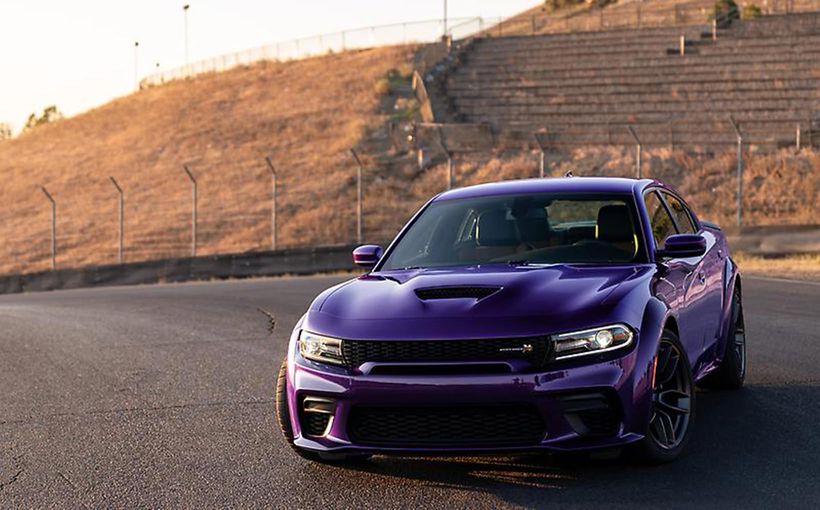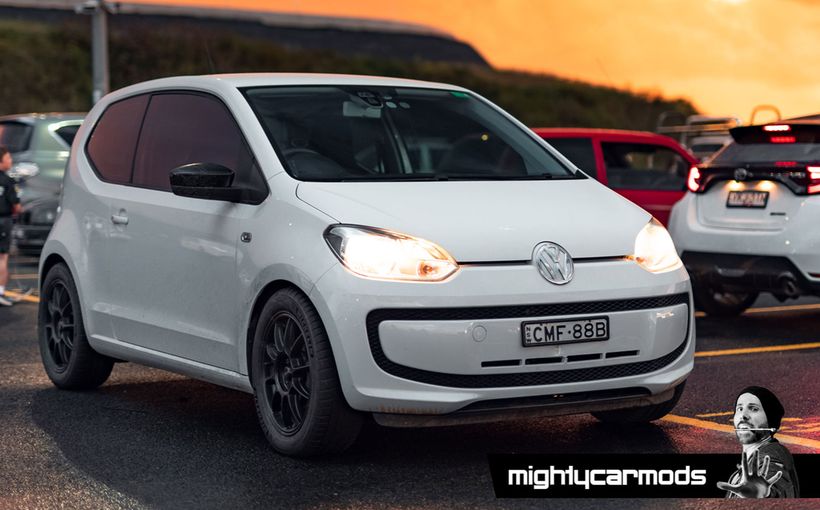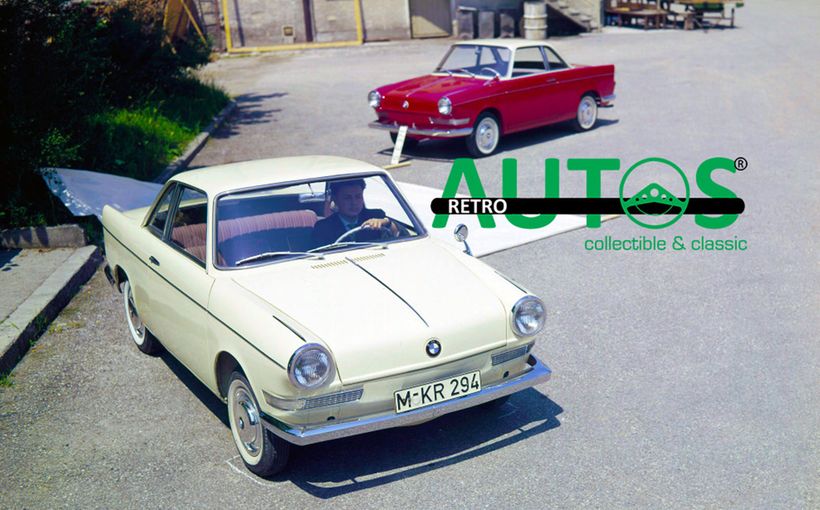Australia’s fastest VW Fastback: Thommo’s ground-breaking V8 Sports Sedan

A Type III Volkswagen would seem an unlikely weapon of choice if you were going into battle against the fastest sports sedans in Australia – unless you bolted a big fuel-injected 500 bhp V8 into the back of it and pulled the trigger!
Bryan Thomson did just that in the mid-1970s and created not only an insane-looking race car but an instant crowd favourite that even today remains vivid in the minds of many fans that witnessed its brief but brilliant career.
In just two thrilling seasons, Thomson (or ‘Thommo’ as the fans called him) in his wild German-American hybrid was Bob Jane’s nemesis in the 1974 and 1975 Marlboro Sports Sedan Series at Melbourne’s Calder Park Raceway.

The nail-biting gladiatorial battles between circuit owner Jane in his 6.0 litre V8 Holden HQ Monaro and Thomson in his 5.0 litre VW-Chev in those two seasons were must-see encounters that attracted huge crowds to each round.
The racing was so close between them that both series were not decided until the final rounds. Jane narrowly prevailed in both, but it was only through cruel luck in the closing laps of the 1975 winner-take-all-final that Thomson was robbed of the series win.
The story behind why Thomson and his chief engineer Peter Fowler decided to build such a car is a fascinating example of Aussie home-grown engineering skills and can-do attitude at their best.

A Formula 5000 with roof and doors
The catalyst for Australia’s wildest VW was Bob Jane’s announcement in 1973 that his Calder Park Raceway would the following year stage the richest motor racing series ever seen in Australia.
Backed by tobacco giant Phillip Morris, the 1974 Marlboro Sports Sedan Series boasted a prize purse totalling $100,000 – an astronomical amount of money at the time and a huge incentive for Jane’s many rivals to try and knock off the tyre retailing giant on his home turf.
Bryan Thomson was racing a very quick V8-powered LJ Torana sports sedan at the time but could see he would need a more radical approach if he was to have a chance of beating Jane and walking off with the bulk of the Marlboro loot.

Thomson and Fowler got their heads together and decided that the ultimate starting point for their new creation would be a Formula 5000 open wheeler; at that time the fastest type of racing car in Australia.
With a purpose-built monocoque chassis, mid-mounted 5.0 litre V8 engine, sophisticated Hewland five-speed transaxle and state-of-the-art suspension design, a Formula 5000 ticked every box on their wish list. The only thing missing were the roof and doors of a sedan.
So the idea was to recreate the layout of a Formula 5000 racing car within the confines of a road car body shell. However, to get the engine sitting directly behind the driver like an F5000, under the rules only a road car that was originally sold with a rear-engine location could do this.

So they looked around at what was available locally. Although Frank Gardner did great things with a Chev Corvair a few years later, that model was never sold in Australia. Instead they looked at cars like the Renault Dauphine, Lotus Europa, Hillman Imp and Volkswagen Beetle, but all were considered either too fragile, too small or both.
However, the car that met all of their requirements was the Volkswagen Type III Fastback. Their confidence was boosted by the fact it also had the same wheelbase as the iconic Ford GT40 Le Mans sports car.
The VW-Chev would pioneer an exciting new direction in sports sedan design. However, by then it was already mid-1973. Thomson and Fowler had only a few months to build the car if it was going to be ready in time for the 1974 season.

As luck would have it, a McLaren M10B Formula 5000 car came on the market which Thomson instantly snapped up as it was the short-cut he was looking for.
With the McLaren sitting in their Shepparton workshop, Thomson and Fowler would have every component they needed which could easily be transferred from one car to the other.
Firstly they removed the Type III’s body shell from its flat floor pan and lowered it over the McLaren to see how everything lined up. Fortunately the McLaren and VW wheelbases were also very close.
So began the process of fabricating and welding a tubular steel space-frame into the body shell, which would serve as both a roll cage for driver safety and a rigid chassis frame that would provide all the locating points for the McLaren’s front and rear suspension assemblies, engine/transmission unit and other ancillaries.
The 302 cid (5.0 litre) fuel injected Chevrolet small block V8 engine, Hewland DG300 five-speed transaxle and rear suspension were all combined in one ‘module’ that could easily be detached and wheeled away by undoing a few bolts and raising the rear of the car.

The engine’s radiator and oil coolers were mounted at the front of the car while the engine sat in its own compartment right behind the driver, skinned with lightweight aluminium sheeting. This included a sealed cold air-box induction system that fed the 480 bhp V8’s intake trumpets huge volumes of air through scoops mounted in each rear side glass.
A fuel tank was mid-mounted (beneath the front passenger seat) so that the car suffered less weight transition as the fuel load lightened. For safety reasons, the fuel tank could not be fitted inside the passenger capsule so the new front floor section was neatly panelled over the top of it.
To reduce weight, hole saws of different diameters were used to remove excess metal throughout the body shell. The bonnet, boot and flared mudguards (to shroud the 10-inch wide wheels and racing tyres) were made from lightweight fiberglass. Thomson claimed the finished car weighed only 1000-1050 kgs.
Just about every component from the McLaren F5000 was used in the construction, right down to the pedal assemblies and even the gear-change mechanism which like the McLaren was mounted on the right hand side of the driver to provide a direct link to the transmission.

Despite such a wild level of modification, Thomson was keen to maintain visual links with the VW road car on which it was based, as he had received some assistance from the Australian VW distributor in the supply of two new body shells and panels for the project.
When race fans stuck their heads inside the cockpit, Thomson wanted them to see that a tangible link - although tenuous at best - had been maintained with the showroom product. Which is why the interior used the standard Type III dash pad, thin-rimmed steering wheel and similar seat trim.
He even went to the trouble of making up his own ‘Volkswagen 5000’ badge that was proudly displayed on the engine cover!

1974 $100,000 Marlboro Sports Sedan Series
After months of solid work, the new VW-Chev met its build deadline and was ready for action by January 1974.
Finished in a striking yellow on black paint scheme, inspired by the Martini Porsches competing in Europe at the time, Thomson and Fowler looked like they had outsmarted the competition - and in many ways they had.
However, one critical design element they overlooked in relation to the car’s suspension geometry would make life difficult for Thomson and hobble the car’s ultimate potential.
By transferring the McLaren’s suspension assemblies directly across to the VW, what had escaped their attention was that the F5000’s roll centre (the longitudinal axis around which a car’s body rolls during cornering) and centre of gravity were only half the height of the VW.
This made the suspension geometry incompatible with the new chassis, meaning the car was literally fighting itself in the corners. Or as Thomson succinctly described it, “dynamically, it was all tangled up inside.”

Once Thomson and Fowler had isolated the problem, they succeeded in refining the car’s handling over time although Thomson admits that they never really got it right. Which makes you wonder how fast this machine could have been without this inherent handicap.
Even so, with 45 per cent of the vehicle’s weight on the front axle and 55 per cent on the rear, its slightly rearward weight bias provided tremendous rear wheel traction off the start line and excellent corner exit speeds.
The only negative was a 5.0 litre engine capacity limit as opposed to 6.0 litres for more conventional production-based cars like Jane’s Monaro. This rule was designed to even out the size and weight advantage of smaller cars, which presented some fascinating performance contrasts.
The unusual machine was an instant favourite amongst the capacity crowds and seen as something of an underdog against the might of the Bob Jane Racing Team in the inaugural 1974 Marlboro series.
Bob had two cars at its disposal that year – the HQ Monaro and his incredible Repco V8-powered LJ Torana – but it was in the Monaro that Jane and Thomson had their greatest clashes.

The raw intensity of their rivalry showed in the number of times they collided with each other during a thrilling series of races throughout the year.
Although Jane sealed the series’ win in the penultimate round, the 1974 Marlboro Series final was a race that will long be remembered as Aussie sports sedan racing at its best.

Under immense pressure from Jane’s Monaro, Thomson led the 20-lap final until the final lap when at around 150 mph (240 km/h) Jane launched what appeared to be an impossible passing move on the VW, under extreme braking into Repco Corner at the end of the main straight.
Jane couldn’t pull up in time and hit the back of Thomson’s car, sending both cars into wild spins that caused both drivers to stall their engines. Jane managed to get his car started before Thomson and raced away to take the chequered flag, to the boos and heckles of fans who didn’t approve of Jane’s driving standards.
Thomson recovered to finish fourth and claimed second overall in the series. After the race Thomson fronted Jane and shared some heated words about the incident, which the crowd just loved of course. And left them hungry for more!

1975 Marlboro Sports Sedan Series
The quality and depth of the competition increased dramatically in 1975. Jane, Thomson and John McCormack in his radical V8-powered Charger had been the front runners in 1974, but were joined by such heavy hitters as Pete Geoghegan’s new HJ Monaro, Frank Gardner in Jane’s Repco V8 Torana, Jim Richards’ 351 Mustang and Allan Moffat’s ‘Cologne’ Capri RS3100 to name a few.
Thomson and Fowler knew they would need something extra if they were going to knock off Jane’s Monaro - and everyone else - in the 1975 Marlboro Series.
The main focus was on overcoming Jane’s power advantage which would require raising the power output of the VW’s 5.0 litre Chev V8 from 480bhp to around 600 bhp.
So they decided to develop a new aluminium cylinder head of their own design inspired by the-then current Porsche Carrera, featuring a toothed belt-driven single overhead camshaft and four valves per cylinder operated by Porsche rocker arms.
With a view to making these new heads available in the huge US aftermarket as a ‘bolt on’ deal, the all-out racing design had to be compromised somewhat to suit the standard Chev small block head stud pattern.

A later evaluation by Cosworth in the UK exposed shortcomings in the inlet tract, port sizing and combustion chamber design which capped the 5.0 litre Chevy’s peak power output at 535 bhp – a useful gain of about 50 bhp but only half of the 100 bhp-plus increase they were chasing.
Thomson started his 1975 Marlboro Series campaign without the new SOHC heads, but decided to give them a run in the penultimate round where the extra 50 bhp was sorely needed.
The 1975 series produced some great action and a variety of winners, but ultimately came down to a winner-take-all final between Jane and Thomson.

With his extra engine power, Thomson and his VW gained the upper hand. Starting from pole position, he took the lead and for 17 of the 20 laps looked headed for his first series victory.
However, fate was to deal him another cruel hand when one of the valve rockers in the new SOHC heads failed with only three laps remaining, which resulted in a dropped valve.
With smoke pouring from the crippled VW, Jane soon caught and passed Thomson to score his second Marlboro Series victory, while Thomson limped across the line in second place to again finish overall runner-up. It was a bitter pill to swallow after coming so close.

A fiery exit
After two seasons, it was all over. Due to his growing business commitments, Thomson called it quits at the end of the 1975 season and sold the car to Vince Gregory without the SOHC engine which Thomson still owns today. Vince didn’t enjoy much success with the car and eventually parked it.
Sadly, things then went full circle for the radical VW-Chev, when it ended up being stripped of all its McLaren components to be used in - of all things - the restoration of a Formula 5000 car! Proof that what goes around comes around.

The VW body shell was rescued by Peter Fowler with a view to completing a full restoration. However, the shell was in bad shape by then and all the original McLaren parts were long gone, so rather than see someone buy it and try to cobble up a poor imitation of the original car, Thomson and Fowler decided to incinerate the shell in a large burn-off at Thomson’s rural property.
It was the end of a great era. And Australia would never see a VW Type III Fastback go so fast again!
Protect your Volkswagen. Call Shannons Insurance on 13 46 46 to get a quote today.

